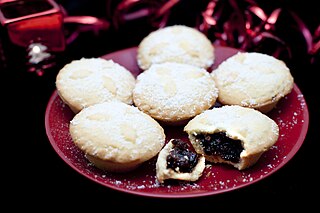
A mince pie is a sweet pie of English origin filled with mincemeat, being a mixture of fruit, spices and suet. The pies are traditionally served during the Christmas season in much of the English-speaking world. Its ingredients are traceable to the 13th century, when returning European crusaders brought with them Middle Eastern recipes containing meats, fruits, and spices; these contained the Christian symbolism of representing the gifts delivered to Jesus by the Biblical Magi. Mince pies, at Christmas time, were traditionally shaped in an oblong shape, to resemble a manger and were often topped with a depiction of the Christ Child.
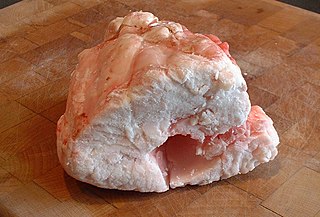
Suet is the raw, hard fat of beef, lamb or mutton found around the loins and kidneys.
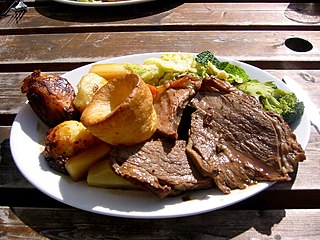
A Sunday roast or roast dinner is a traditional meal of British origin. Although it can be consumed throughout the week, it is traditionally consumed on Sunday. It consists of roasted meat, roasted potatoes or mashed potatoes, and accompaniments such as Yorkshire pudding, stuffing, gravy, and condiments such as apple sauce, mint sauce, or redcurrant sauce. A wide range of vegetables can be served as part of a roast dinner, such as broccoli, Brussels sprouts, cabbage, carrots, cauliflower, parsnips, or peas, which can be boiled, steamed, or roasted alongside the meat and potatoes.

Pudding is a type of food. It can be either a dessert, served after the main meal, or a savoury dish, served as part of the main meal.

A blood sausage is a sausage filled with blood that is cooked or dried and mixed with a filler until it is thick enough to solidify when cooled. Most commonly, the blood of pigs, sheep, lamb, cow, chicken, or goose is used.

Spotted dick is a traditional British steamed pudding, historically made with suet and dried fruit and often served with custard.

Christmas pudding is sweet, dried-fruit pudding traditionally served as part of Christmas dinner in Britain and other countries to which the tradition has been exported. It has its origins in medieval England, with early recipes making use of dried fruit, suet, breadcrumbs, flour, eggs and spice, along with liquid such as milk or fortified wine. Later, recipes became more elaborate. In 1845, cookery writer Eliza Acton wrote the first recipe for a dish called "Christmas pudding".
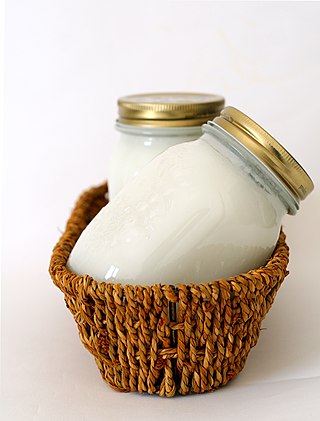
Shortening is any fat that is a solid at room temperature and is used to make crumbly pastry and other food products.

White pudding, oatmeal pudding or mealy pudding is a meat dish popular in the British Isles.

Peasant foods are dishes eaten by peasants, made from accessible and inexpensive ingredients.

RHM plc, formerly Rank Hovis McDougall, was a United Kingdom food business. The company owned numerous brands, particularly for flour, where its core business started, and for consumer food products. It was listed on the London Stock Exchange and was once a constituent of the FTSE 100 Index but was acquired by Premier Foods in March 2007; many of its brands continue to be produced.

The Bedfordshire clanger is a dish from Bedfordshire and adjacent counties in England, such as Buckinghamshire and Hertfordshire. It dates back to at least the 19th century. It is still available at various bakers and served at some cafes, restaurants and local places of interest.

Steak and kidney pudding is a traditional British main course in which beef steak and beef, veal, pork or lamb kidney are enclosed in suet pastry and slow-steamed on a stovetop.
A suet pudding is a boiled, steamed or baked pudding made with wheat flour and suet, often with breadcrumb, dried fruits such as raisins, other preserved fruits, and spices. The British term pudding usually refers to a dessert or sweet course, but suet puddings may be savoury.

Sussex pond pudding, or well pudding, is a traditional English pudding from the southern county of Sussex. It is made of a suet pastry, filled with butter and sugar, and is boiled or steamed for several hours. Modern versions of the recipe often include a whole lemon enclosed in the pastry. The dish is first recorded in Hannah Woolley's 1672 book The Queen-Like Closet.
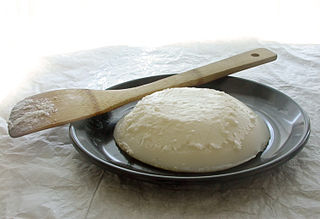
Lard is a semi-solid white fat product obtained by rendering the fatty tissue of a pig. It is distinguished from tallow, a similar product derived from fat of cattle or sheep.

Fijian cuisine has long consisted of primarily foraged and farm-grown food. Although rice, wheat, and tea all became staples during Fiji's colonial era, native Fijians still eat primarily tubers and coconuts. The cuisine of Fiji is known for its seafood and various green vegetables, including ''ota'', a young forest fern, and ''bele'', a plant that resembles spinach.

Black pudding is a distinct national type of blood sausage originating in the United Kingdom and Ireland. It is made from pork or occasionally beef blood, with pork fat or beef suet, and a cereal, usually oatmeal, oat groats, or barley groats. The high proportion of cereal, along with the use of certain herbs such as pennyroyal, serves to distinguish black pudding from blood sausages eaten in other parts of the world.















